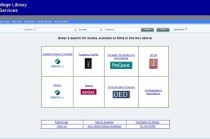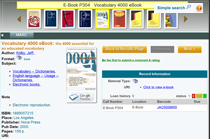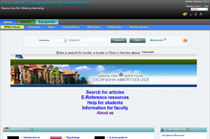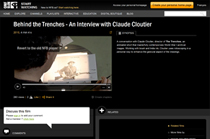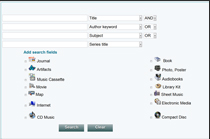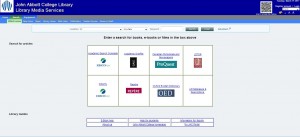”We migrated to OPALS this year, an open-source ILS which is a fraction of the cost of proprietary systems. The transition was incredibly painless and the customer support is prompt, empathetic and thorough.”Academic Librarian
OPALS IN ACADEMIC LIBRARIES |
OPALS is a virtual library that professors and students use to access their institutions’ digital and print resources 24/7.These resources include:
College library staff add and customize MARC records, circulate resources, manage database authentication, remote access and consolidated database use-statistics to maximize their return on technology expenditures. Unicode compatibility makes Click here for our demo site link and login it possible to catalog in most Unicode supported languages, and Web-based technology enables local hosting or hosting on OPALS servers. College & Seminary LibrariesJohn Abbott College, Quebec, Canada Bethlehem College & Seminary, MN Educational Development Center, Amman, Jordan Séminaire Baptiste Évangélique du Québec 衛道神學研究院 主頁 Wesleyan Graduate Institute Library, Hong Kong, China |
OPALS ACADEMIC LIBRARies FUNCTIONALITY
- OPALS Public Access Catalogue (OPAC)
- Multilingual displays (English, French, Spanish, Czech, Arabic)
- Enlarge type font displays
- Choose OPAC screen display colours
- OPAC displays and searches Roman alphabet and Unicode languages (ex. Arabic, Chinese, Hebrew)
- Select any indexed MARC field for searching
- Advanced Search – Define default search fields
- Filter searches by media format (e-books, audio, video, books etc.)
- Beginner’s search – Graphic / icon searching
- Beginners search Icons linked to search arguments
- Beginner’s search options for keyword, author, title, subject searches
- K-2 Search Interface
- Virtual shelf browsing
- Configure external database search tabs (federated search)
- External searching: Gale, Ebsco, ProQuest, Grolier, and CERF
- Configure integrated Z39.50 Client Protocol searches external databases
- Authenticate Z39.50 searching where required
- OPAC – integrated Z39.50 Server Protocol – can be searched by external Z39.50
- Boolean searching – Within and between fields
- Boolean searching between keywords
- Left, right, embedded truncation
- Adjacency searching
- Sort search results (Author, Title, Classification, Year – Ascending, descending order)
- Brief, expanded, full MARC citation displays
- Brief citation list displays highlighted search argument keywords
- Brief citation – add to bibliography check box
- Brief citation – Virtual shelf browse displays items adjacent to those that are selected
- Brief citation – Displays faceted search results that decode the bibliographic records
- Brief citation – Option to submit and view reviews & ratings
- Brief citation – Displays resource thumbnails (book jackets, etc.)
- Brief citation – Displays media format icons
- Brief citation – Displays item status (in, out, holds, etc.)
- Keyword search results screen provides subject browser option to view results’ headings
- Subject browser finds and lists all subjects containing keywords
- Subjects listed alphabetically, contain searched keywords (first, middle or end of heading)
- Select up to six subject headings and execute a consolidated search
- Subject browser displays alphabet – click on a letter to start browsing
- Expanded search display provides access to MARC editing for authorized staff
- Expanded display navigation to “next” and “previous” expanded record
- Expanded display – displays highlighted search argument keywords
- Expanded display – Virtual shelf browse displays items adjacent to those that are selected
- Expanded display – Displays “Similar Items” in display pane on the right hand side of the screen
- Expanded display – Option to submit and view reviews & rating
- Expanded display – Displays resource thumbnails (book jackets, etc.)
- Expanded display – Displays media format icons
- Expanded display – Displays item status
- Expanded display – add to bibliography check box
- Expanded display – authorized users can edit records
- Expanded display – authorized users can reserve / place holds
- Expanded display – authorized staff can click on barcodes to view / change item status details
- Expanded display – authorized staff can click on barcodes to change loan categories
- Expanded display – authorized staff can click on barcodes to view circulation statistic
- Expanded display – hyperlink search author, subject headings, series
- Expanded display – 505 detailed contents format replicates publisher content pages
- Displays, identifies (when 856$3 is used) and hyperlinks 856 URI addresses
- Identifies 856 links in the expanded record displays
- 856 links to content (ex. ebooks, multimedia, etc.)
- Formats and displays legibly, 505 contents notes (especially useful for large entries)
- Bibliographies: Mark items to create sorted bibliographies on the brief citation listing
- Bibliographies: Mark items to create sorted bibliographies on the expanded citation listing
- Bibliographies: Add a “Title” to a bibliography (theme, topic, assignment, etc.)
- Bibliographies: Add a date to the bibliography
- Bibliographies: Add a comment to each bibliographic resource
- Bibliographies: APA, MLA & Shelflist order Bibliographic formats
- Bibliographies: Option to include or exclude item summaries
- Bibliographies: Bibliographies can be emailed
- Bibliographies: Print bibliographies
- Pathfinders – create and organize topical groups … link resources to circ status and thumbnails
- Pathfinders – Create lists of Weblinks and descriptions
- Pathfinders – Upload PDF, Jpeg, Word, handouts
- Resource icons – linked to leader (books, video, etc.)
- Item status (copies, in, out, reserved, date due)
- Federated search – Multiple database authentication
- Federated search – Simultaneous searching
- Federated search – Aggregate bibliographies
- Database authentication and use statistics reporting
- Portal Widgets: Customize OPAC mast, slogan, JPEG
- Add links to administrative / institution Websites
- Authenticated “My file” – Patron transaction file access
- “My file” – Self service reservation (if permitted)
- “My file” – check transactions (if permitted)
- Portal Customization Widgets
- OPALS Cataloging
Complete MARC records can be stored, edited, imported, merged, and exported
-
- Import MARC records from diskettes & files
- Verifies 852a & b – adds default codes
- Adds default item circulation code
- Add an 852 subfield to imported records (ex. Add 852x… “LSTA 2007”)
- Checks for duplicates
- Merge options (new to old, old to new record)
- View Items Added for specific date ranges
- Import & merge items with holdings that have “duplicate” barcodes (union issue)
- Import & merge items and holdings that do not have barcode
- Retains import log – lists import details and user id
-
- Z39.50 client integrated import & edit function
- Import MARC records from any Z39.50 database
- Import list displays author, title, publisher, date,
- 852 holding template for copy information data
- Auto adds default 852a & b (location codes)
- Adds imported record classification (852h, I)
- Multiple holdings: enter first and last barcode
- Auto adds number of 852 holdings between 1st & last barcodes
- Auto increments barcode numbers in 852p field
- Auto-add text (ex. budget and year) to a designated 852 subfield
- Modify & add data to any field – full screen editing
- Add & edit fields to imported records
- Verifies for duplicates in the catalog and identifies them during import process
- Provides access to previously entered records & option to add new holding to it
- Staff can verify duplicates items list, compare and designate best record to retain
- Designated record aggregates holdings of both records in 852 fields
- Subject authority browsing, selection and saving to a record in real time (no cutting and pasting)
- Global item type reassignment utility (“circulation category”)
- Deleted items report (…for designated date range)
- Item Acquisitions report to display new acquisitions & edits for designated dates
- Item Acquisitions report sorts by record id, author, call number
- Item Acquisitions report displays date of entry and barcode number
- Acquisitions report hyperlinks record id, title to display, edit, delete, or reserve
- Acquisitions report hyperlinks barcode to edit item status, loan duration
- Acquisitions report hyperlinks barcode to view transactions, and statistics
- Acquisitions report includes “pick-list” to select items to appear on OPAC “New Items” list
- Acquisitions report includes “pick-list” to print barcode, pocket spine label sets
MARC Record Export
-
- Create an export hitfile, export part of a database, export then entire database
- Export XML-MARC record from their databases,
- Converts to MARC21 format files
Original Entries
-
- Define MARC templates for original entries (books, videos, etc.)
- Full screen data entry
- Select font size
- Select screen color preference
- Display field tag descriptions (… or not)
- Pop-up field and subfield pick lists when adding same
- Parse 008 field
- List 008 field authorities
- Edit Indicator bytes & subfield indicators
- Add 852 holding to existing record
- Add a field to existing record
- Add new item using template (Original cataloguing)
- Delete 852 Records and holdings
- Add 856 “Universal Resource Indicator” (URI)
- 856 URI is hyperlinked and appears in OPAC displays
MARC Record Utilities
-
- 852 Holdings Field and Subfield Search / Edit
- Specify date ranges, school year, or search all
- Search any 852 subfields for specific data
- Search & identify subfields that do not have data but should (ex. Circulation code)
- Lists records containing that data (ex. “LSTA 2005”)
- List includes Internal ID #, Title, Author, Call #, Barcode
- Hyperlinked title to access a specific record for editing
- Globally modify a specific record’s data, a selected group, or range
- Globally add data to subfields that should have data
- System logs global modification details (dates, records changed, staff id)
- Record merging utility to merge identical holdings and consolidate multiple holdings to it.
Circulation management functions use barcodes and barcode readers to manage loans, returns, reserves, renewals, etc.
Loans (Scan item barcodes)
-
- Partial borrower name entry permitted – system displays pick-list
- Displays patron transactions and reserves pending
- Displays damaged items list
- Consecutive loans to same borrower number
- Alert if item is on reserve for another borrower
- Print reserve slip to place in book & notice to send to borrower
- Option to email reserve ready notice to borrower
- Alert if patron has overdues (override for authorized staff)
- Renewals by barcode or by item title & patron name or number
- Renewals of individual, selected or all items from patron “loans” display
- Renewals calendar can override system default for shorter or longer period
Reserves
-
- Reserves by title – manages multiple copies
- Reserve by barcode number or title
- Patron self-service reservations authorization (… when allowed)
- Reserve groups of items to a borrower
- Reserve priority based on date and time
- Alert when items returned have reserves
- Print a reserve ready notice and reserve slip to place in the book pending pickup
- In-house library use scanning and statistics
- Distinct audible alerts for transaction confirmation or exceptional circumstances
- Expired reserves removed from system
- Block patrons with overdue items
- Override blocks for authorized staff
- Calendar to override system transaction default dates
- Return individual, selected or all items on loan from borrower “loans” display
- Return blocked patrons overdue items without leaving circulation program
- Scan borrower barcodes
- Touch-screen compatible
- Instant access to database and OPAC searching without logging out
- Patron self-service reservations authorization
- Unlimited, configurable patron categories
- Patron limits: Maximum loans, holds, reserves, renewals
- Patron priorities… certain patrons can have designated loan periods
- Permits patron categories that override standard loan limits for designated items
- Patron ILL authorization
- Displays scanned patron demographics
- Displays scanned patron outstanding transactions
- Define loan, renewal, reserve limits
- Print & Sort Overdue Notices using Date Ranges
- Unlimited item categories
- Item loan duration: loans, grace period, renewal, reserve, hold
- Non-circulating status
- Global item type reassignment utility (“circulation category”)
- Designate lost items
- Designate damaged items
- Circulation Statistics (Items / Patrons)
- Closing day and holiday calendar
- Calendar or school year
- Schedule and describe closing dates
An inventory program is available to scan the collection barcodes then list and mark items that are missing, and not in circulation.
-
- Use a portable device to scan item collection
- Upload records for comparison with database barcodes
- Produces a list of barcodes not scanned, sorted by classification number
- Verify list and add any items not scanned before printing a list of missing items
- Mark missing items
- Print list of items incorrectly shelved
- Print list of items that circ considers “on loan”
- Incorrectly shelved Items loaned but scanned… lists closest Dewey #
- Correct status to “on shelves” for individual, selected or all items from this list
- Print list of items previously considered “missing” but that turned up on the shelves
- Change status of found items from links that appear on the lists
- Staff not required to exit inventory, access editor, look up each item, to modify
- status
- List of invalid barcodes that were scanned, and relative shelf location
- Partial inventory – by Dewey range / or item type
A member’s database includes and functions that permit manual data entry or data import of demographic information.
-
- Add, Edit, Delete Users
- Import User Demographics from other sources
- Import can overlay new data in existing records.
- Import patron pictures
- Group editor: lists members, select all, sort, lists transaction stats, prints lists & barcodes
- Group editor list provides hyperlink to edit individual borrower demographics
- Group editor hyperlinks transaction status to view transaction details
- Unlimited user types
- Access to specific functions is configurable: Circ, ILL, Item edit, Patron edit, etc.
- User profile links to a specific building
- Three parent / guardian references
- User email, school & home address
- User & Admin Login / Password to authorized functions
- Search patron database
- OPALS Reports & Notice
Dynamically created reports give important relational data for system wide information.
Overdue notices & lists
-
- Date range selection: Visual calendars, fiscal year, or manual entry
- Overdue notices & lists
- Interactive calendar to specify date ranges
- Date range selection: By visual calendars, fiscal year, or manual entry
- Lists paginate by class, homeroom or teacher; select one, some or all to print
- Sort options: Grade, homeroom, name
- Notice includes item title, classification number, due date
- Prints 1, 2 or 3 notices per page (uses PDF format to ensure proper alignment)
- Add a custom note to notices
- Email overdue notices or lists
Reserved Item Lists
-
- Reserve items by searching the database
- Reserve items by barcode number
- Reserve list sorts by User Name, Dewey, Date of Reserve, Expiry Date.
- Date range selection: By visual calendars, fiscal year, or manual entry
- Reserve priority list management
- Lists all reservations, reserves available for pickup, and reserved items not yet available.
- Column to display if an item is a reserve or hold (sorts).
- When sorting by the “reserve/hold status column,” it will sub-sort by the user name
Advanced Booking & Reserve Shelf Management
-
- Search for and request a list of resources for a particular range of dates
- Advanced booking request are displayed on the staff “Task Reminder” list
- Library staff can assemble the requested resources, place them on a reserve shelf and notify requester that they are ready for pickup by email
Circulation Transaction List
-
- Calendars to select date ranges
- Date range selection: By visual calendars, fiscal year, or manual entry
- Group outstanding transactions by homeroom, grade, teacher, user
- Select a class or all groups to print a list
Stores & searches diacritics
-
- List and subsort all items in a library collection
Lost Items List
-
- Creates prints lost items list for a selected date range.
- Date range selection: By visual calendars, fiscal year, or manual entry
- Option to select holdings to delete
- Sort options author, call number
- Option to retain records that do not have any holdings for union databases
- Option to delete MARC record when the last holding has been deleted (building)
- Select or deselect all items on a page for printing and deletion.
- Lost item barcode is hyperlinked to the item’s status screen. Permits rapid access to modify the item’s status, or review the item’s statistics to determine whether it should be replaced.
- Hyperlinked title provides rapid access to the item’s MARC record and MARC editor functions.
New Acquisitions List
-
- Select items from the item acquisitions list for OPAC display
- Users click on “New Items” in OPAC to display current acquisitions
- System removes selected items from the list on staff-designated expiry date
- Users can click on 30-45-60 days to view new acquisitions
Deleted items list
-
- Creates prints deleted items list for a selected date range.
- Date range selection: By visual calendars, fiscal year, or manual entry
- List sorts by item #, author, call number, deletion date
- Select or deselect individual items or whole pages of deleted items for the report
- Displays the number of records and holdings deleted for the date range
Circulation statistics
-
- Interactive calendar to specify date ranges
- Date range selection: By visual calendars, fiscal year, or manual entry
- Sort by Dewey, Dewey 10′s, Dewey 100′s
- Statistics by special collections (Fic, Ref, etc.)
- Sort by Grade, homeroom
Acquisitions lists
-
- Interactive calendar to specify date ranges
- Date range selection: By visual calendars, fiscal year, or manual entry
- List items imported, and entered for specified dates
- Sort acquisitions lists by author, title, classification
Item Spine & Barcode Label Set Printing
-
- Prints sets of three labels:
- 1 X Spine label – bold print
- 2 x Barcode labels… also prints classification #, author, title
- Sort item acquisitions list: Title, Author, Classification #
- Select one or many items for label printing
- Print individual spine labels using a Dymo 450 printer
Patron Barcode Printing
-
- Print barcode for a borrower or group of borrowers
- Include or exclude borrower types and status (ex. staff, teachers, blocked, inactive etc.)
- Barcode includes eye-readable number, and borrower name
Database Subscription Management & Authentication
-
- Vendor database contains list of subscription database vendors
- Vendor database lists products for each vendor including logos and thumbnails
- Subscriber information filters from region to district to branch or school libraries
- Subscriber information aggregates subscriptions for each branch… can be customized by branch
- Subscriber information enables authentication using a common username & password or patron ID number
- Branch database subscription menus group subscription databases by topic and offer other A-Z listing views
- System aggregates use-statistics locally and can report statistics from all vendors for any specified date ranges
- System provides hierarchical authorization to administrative functions
Equipment Management
-
- Database records pertinent equipment information
- Include url link to online equipment manuals
- Uses OPALS patron database
- Hourly loans
- Notices
Textbook Management
-
- Database records pertinent textbook data
- Includes teacher and course tables
- Can link teachers and courses to specific textbooks and students to whom they are loaned
- Generates notices
OPALS can be used as a union catalog, providing options to focus a search within a district or even on a specific school.Manage multiple buildings & multiple regions ILL.
-
- Integrated Z39.50 Server & Client Protocol
- Manage multiple buildings & multiple regions ILL (ex. Multiple BOCES SLS)
- Scope: Search all sites (Regions, Districts, Individual buildings)
- Scope: Search by District
- Scope: Search Specific building
- Set default to search a specific building
- Directory: Individual building codes, data, contacts, addresses
- Search results display location codes and names
- Retains building level multiple copy barcodes
- Manages inter-site duplicate barcodes (Where systems do not use distinct barcodes)
- Import records & update holdings from vendor or site – provided files
- Identify duplicate records for merging
- Merge options record options
- Batch deletions from site-provided deleted items files (May 2007)
- Updates & deletions capable for multiple automation systems in a region
- XML-MARC database structure
- Unicode compatible (Non Roman Alphabet languages)
- Stores & searches diacritics
- Security levels and access for regional administrators & building level staff
- Reports item status in OPALS-automated branches
- Portal & Widget Options
Import records
-
- Identify duplicate records for merging
- Merge options (New item to original or original to new)
XML-MARC database structure
-
- Export XML-MARC or MARC21 records
Unicode compatible
-
- Stores & searches diacritics
Support interlibrary loan services (requests, responses, packing list printouts, and tracking) in a region or among affiliated locations.
-
- Launch ILL request to multiple buildings
- ILL form includes private and public note box
- Requests emailed to contacts in system directory
- Email notification includes a hyperlink to ILL details
- Item request made simultaneously to selected locations
- System prevents response duplication
- Accommodates multiple copy requests using a single request template and wizard
- Response form includes modifiable due date calendar
- Prints shipping label / packing list to send with item
- Emails message that item is en route
- Tracks item receipt, and return
- Form to request items not in the database
- Retain ILL request and response statistics
- Authenticate authorized users
- Directory of buildings: addresses, contacts, email & phone numbers location codes, etc.
- ILL statistics reports: Requests, requests filled, not filled, etc. by region / building
- Logins provide access to individual locations and statistics
- OPALS Preferences (Configuration)
Each OPALS Library can make their own choices for how the circulation and OPAC system operates. Default user category.
-
- Default user category
- SMTP Server (for email related functions)
- Language default
- Library code
- Report group sort defaults (primary, secondary, tertiary)
- OPAC Advanced Search Field defaults
- Circ Screen timeout limit
- Login Session timeout limit
- Union catalog display options
- Fiscal Year defaults (ex. school year)
- Search attribute order
- Any number of user types or item types can be created.
- Other databases can be added for federated searching.
- Select your imported records from any z39.50 server in the world
- etc . . .
- OPALS Operational Requirements
Equipment
Server
-
- Related to database size and numbers of buildings served. We do not recommend using a virtual environment unless your requirements are minimal.
- Faster is better for all functions
- Processor: (minimum) Intel P4, speed: 2+ GHz
- RAM: Suggested minimum 8GB
- Hard drives: 200+gigs; SCSI preferred.
Workstations (OPACS)
-
- Minimum 1GHz processors
- 512 MB of RAM
- Color monitor with 1024 x 768 resolution
- Internet-connected
Technical workstations for data entry, and transaction processing
-
- 1.2 GHz processor
- 1024 MB of RAM
- Color monitor
- Sound capacity with speakers
- Internet-connected
Desirable Peripherals:
-
- Touch screen monitor (Circulation desk, OPACs)
- Laser Printer
- Barcode Reader (…”hands-free” stand)
- Portable computer with Barcode Reader (for Inventory)
Supplies:
-
- Barcodes
- Barcode label protectors
- Printer cartridges
Operating System / Software:
-
- Red Hat Linux ES 5 ; or CentOS 5
- Apache
- Perl
- Zebra
- MySql
Brief citation – Displays faceted search results that decode the bibliographic records
———————————————————————————————————————————————————————————————————————————
-
”MediaFlex, which offers and maintains OPALS for us, has been consistently the most responsive company in terms of customer support. Having worked with them since 2007, we continue to enjoy a close working relationship.”
School Librarian -
”Thanks to OPALS, 85-90% of our incoming back-office tasks are now smoothly handled automatically – against the former only 10%. We did not experience any troubling side-effects of any kind during/after implementation”
Bazh-GFx Academic Librarian”I can't believe that in an era like this I can still pick up the phone and get connected right away with people who are directly running the business and solve the problem right then and there. It is so rare and I deeply appreciate that! I will reach out to a few other small schools in my area and let them know about your company!”
School Librarian -
”We migrated to OPALS this year, an open-source ILS which is a fraction of the cost of proprietary systems. The transition was incredibly painless and the customer support is prompt, empathetic and thorough.”
Academic Librarian”MediaFlex, which offers and maintains OPALS for us, has been consistently the most responsive company in terms of customer support. Having worked with them since 2007, we continue to enjoy a close working relationship.”
School Librarian -
”Thanks to OPALS, 85-90% of our incoming back-office tasks are now smoothly handled automatically – against the former only 10%. We did not experience any troubling side-effects of any kind during/after implementation”
Bazh-GFx Academic Librarian”I can't believe that in an era like this I can still pick up the phone and get connected right away with people who are directly running the business and solve the problem right then and there. It is so rare and I deeply appreciate that! I will reach out to a few other small schools in my area and let them know about your company!”
School Librarian -
